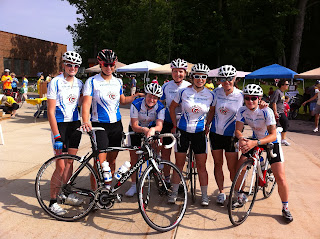I generally bike a minimum of 90 minutes nearly every day and have been on rides recently up to about 7 hours. The intensity varies quite a bit since I am sometimes working on intervals, often climbing and also often descending back down those climbs. My goal is to use the exercise mode with no lows or near lows, no serious or prolonged highs, and the ability to fuel my exercise rather than my blood sugar.
**Note! I am not a doctor! While I feel confident adjusting my pump settings, and my endocrinologist has basically said, "Why are you asking me? You know how to figure it out," please do not interpret this post as medical or insulin dosing advice. Check in with your doctor, please.**
The short story is that I created a cycling profile with sensitivity factors 2.5 to 3.5 times my normal settings, increasing every hour or two over a period of about 6 hours. So, for example, instead of 1:55, I am using 1:170 for the first hour. My basal rates stay about the same initially, since I tend to spike during the first hour, and then taper every hour or two. I can then allow the CIQ algorithm to automatically adjust basals and give correction boluses without messing around with it too much, but also eat when I need to. Initially I was taking a small 0.05 unit bolus to prevent CIQ from auto-bolusing, but this is hard to remember to do for longer rides, and I do want to be able to prevent highs as well. I turn on the profile and exercise mode right before I head out, because I also eat a small snack (about 11 g carbs) and tend to go high in the first hour.
I have modified my on-bike food to include foods with a bit of protein and fat, but still pack a ton of gels to bring me out of lows should I encounter them. FWIW if I ever get a hunger pang during a ride, it almost always is a precursor to falling BGs.
 |
| A recent ride beginning 6 AM and ending around 11. I ate about 100 cals/hour. Ride included 3 50-minute mountain climbs. |





